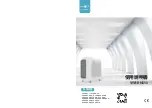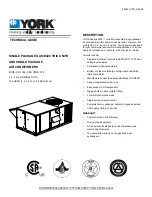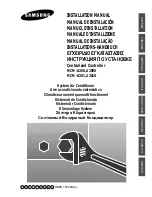
6 Installation
Installer and user reference guide
23
RXYTQ8~16U7YF
VRV IV+ heat pump for high ambient temperatures
4P561157-1 – 2018.09
If there is a possibility of moisture being present in the refrigerant
piping (for example, water may have entered the piping), first carry
out the vacuum drying procedure below until all moisture has been
removed.
All piping inside the unit has been factory tested for leaks.
Only field installed refrigerant piping needs to be checked.
Therefore, make sure that all the outdoor unit stop valves are firmly
closed before performing leak test or vacuum drying.
NOTICE
Make sure that all (field supplied) field piping valves are
OPEN (not outdoor unit stop valves!) before you start leak
test and vacuuming.
For more information on the state of the valves, refer to
"6.5.3 Checking refrigerant piping: Setup" on page 23
6.5.2
Checking refrigerant piping: General
guidelines
Connect the vacuum pump through a manifold to the service port of
all stop valves to increase efficiency (refer to
refrigerant piping: Setup" on page 23
).
NOTICE
Use a 2-stage vacuum pump with a non-return valve or a
solenoid valve that can evacuate to a gauge pressure of
–100.7 kPa (−1.007 bar)(5 Torr absolute).
NOTICE
Make sure the pump oil does not flow oppositely into the
system while the pump is not working.
NOTICE
Do not purge the air with refrigerants. Use a vacuum pump
to evacuate the installation.
6.5.3
Checking refrigerant piping: Setup
p< p>
R410A
N2
C
b
c
e
a
g
f
d
A
B
a
Pressure reducing valve
b
Nitrogen
c
Weighing scales
d
Refrigerant R410A tank (siphon system)
e
Vacuum pump
f
Liquid line stop valve
g
Gas line stop valve
A
Valve A
B
Valve B
C
Valve C
Valve
State of valve
Valve A
Open
Valve B
Open
Valve C
Open
Liquid line stop valve
Close
Gas line stop valve
Close
NOTICE
The connections to the indoor units and all indoor units
should also be leak and vacuum tested. Keep any possible
(field supplied) field piping valves open as well.
Refer to the indoor unit installation manual for more details.
Leak test and vacuum drying should be done before the
power supply is set to the unit. If not, see also the flow
chart earlier described in this chapter (see
checking the refrigerant piping" on page 22
).
6.5.4
To perform a leak test
The leak test must satisfy the specifications of EN378‑2.
To check for leaks: Vacuum leak test
1
Evacuate the system from the liquid and gas piping to
–100.7 kPa (–1.007 bar)(5 Torr absolute) for more than 2 hours.
2
Once reached, turn off the vacuum pump and check that the
pressure does not rise for at least 1 minute.
3
Should the pressure rise, the system may either contain
moisture (see vacuum drying below) or have leaks.
To check for leaks: Pressure leak test
1
Break the vacuum by pressurising with nitrogen gas to a
minimum gauge pressure of 0.2 MPa (2 bar). Never set the
gauge pressure higher than the maximum operation pressure of
the unit, i.e. 4.0 MPa (40 bar).
2
Test for leaks by applying a bubble test solution to all piping
connections.
3
Discharge all nitrogen gas.
NOTICE
Make sure to use a recommended bubble test solution
from your wholesaler. Do not use soap water, which may
cause cracking of flare nuts (soap water may contain salt,
which absorbs moisture that will freeze when the piping
gets cold), and/or lead to corrosion of flared joints (soap
water may contain ammonia which causes a corrosive
effect between the brass flare nut and the copper flare).
6.5.5
To perform vacuum drying
NOTICE
The connections to the indoor units and all indoor units
should also be leak and vacuum tested. Keep, if existing,
all (field supplied) field valves to the indoor units open as
well.
Leak test and vacuum drying should be done before the
power supply is set to the unit. If not, see
checking the refrigerant piping" on page 22
information.
To remove all moisture from the system, proceed as follows:
1
Evacuate the system for at least 2 hours to a target vacuum of
–100.7 kPa (–1.007 bar)(5 Torr absolute).
2
Check that, with the vacuum pump turned off, the target
vacuum is maintained for at least 1 hour.
3
Should you fail to reach the target vacuum within 2 hours or
maintain the vacuum for 1 hour, the system may contain too
much moisture. In that case, break the vacuum by pressurising
with nitrogen gas to a gauge pressure of 0.05 MPa (0.5 bar)
and repeat steps 1 to 3 until all moisture has been removed.
Содержание VRV IV+ RXYTQ8U7YF
Страница 61: ......
Страница 62: ......
Страница 63: ......
Страница 64: ...4P561157 1 2018 09 Copyright 2018 Daikin...
















































